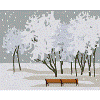Landscape Architecture Program
Date of this Version
Fall 9-15-2013
Abstract
Background readings on scale plus twenty-three visual landscape assessment studies from 1968 to 2006 were examined to understand the nature and use of scale and its relationship to the visual environment. The objectives of this study were to: 1) describe the concept of scale as applied to visual assessments, 2) review scale use in selected visual assessments, and 3) identify issues that need further research to better integrate scale into visual landscape assessments and landscape ecological theory.
Basic concepts and features relating observers with landscape and scale required defining scale, bounding visibility, perceiving scale, seeing hierarchically, and visualizing grain and extent.
Finally, it recommends further research for defining, recognizing, and incorporating scale into visual landscape studies should: 1) explicate use of absolute and relative scale, 2) compare traditional and multi-scalar, hierarchical approaches, 3) examine and revise the current reliance on substitution of distance for extent or scale, 4) compare space/mass interactions, not simply masses, to determine visual grain, 5) design research protocols in which psychophysical metrics correlate more logically with eco-physical metrics.

